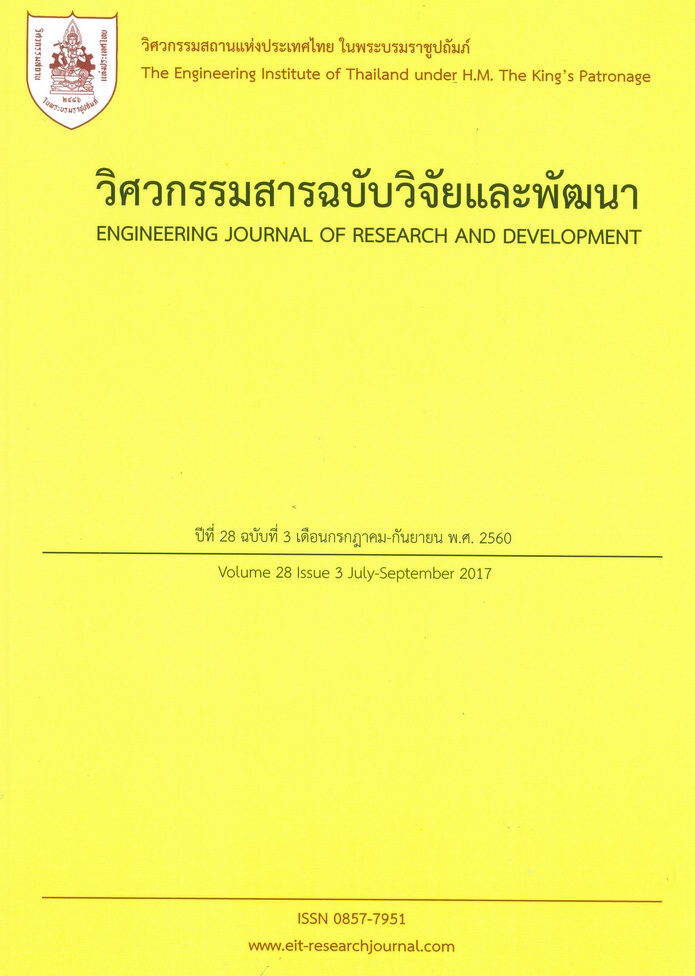กราฟสเปกตรัมผลตอบสนองที่สร้างจากผลเจาะสำรวจดินในจังหวัดพะเยา
Main Article Content
Abstract
บทความนี้ นำเสนอแนวโน้มของกราฟสเปกตรัมผลตอบสนอง ที่ใช้สำหรับการออกแบบอาคารต้านทานแผ่นดินไหวด้วยวิธีพลศาสตร์ ตามมาตรฐานของกรมโยธาธิการ (มยผ 1302-52) โดยกราฟดังกล่าวนี้สร้างขึ้นจากผลการเจาะสำรวจดินในสนาม ในเขตอำเภอเมือง จังหวัดพะเยา ทั้งหมด 35 หลุมเจาะ ข้อมูลคุณสมบัติของดินภายในหลุมเจาะ ถูกนำมาใช้คำนวณเพื่อสร้างเป็นความสัมพันธ์ระหว่างความเร่งตอบสนองกับคาบธรรมชาติ เพื่อให้ได้กราฟสเปกตรัมผลตอบสนองแบบจำเพาะเจาะจงในสถานที่ที่อาคารตั้งอยู่ ผลการศึกษาพบว่า กราฟที่ได้มีแนวโน้มที่จะให้ค่าผลตอบสนองเป็นไปตามลักษณะของดินแบบ C ร้อยละ 60.0 รองลงมากราฟเป็นไปตามลักษณะดินแบบ D ร้อยละ 34.3 และกราฟเป็นไปตามลักษณะดินแบบ E ร้อยละ 5.7 โดยกราฟมีลักษณะ SD1<SDS ทั้งหมด นอกจากนี้แล้ว ผู้วิจัยได้รวบรวมกราฟดังกล่าวเผยแพร่บนเว็ปไซต์ของคณะวิศวกรรมศาสตร์ มหาวิทยาลัยพะเยา (http://www.ce.eng.up.ac.th/response_curve/) เพื่อให้วิศวกรออกแบบ หรือผู้ที่สนใจ สามารถดาวน์โหลด ข้อมูล เพื่อใช้เป็นข้อมูลอ้างอิงเบื้องต้นสำหรับการออกแบบอาคารต้านทานแผ่นดินไหวในบริเวณตำแหน่งที่ใกล้เคียงกับหลุมเจาะ ในเขตอำเภอเมือง จังหวัดพะเยา ได้อย่างสะดวกอีกด้วย
SEISMIC RESPONSE SPECTRUM CURVE CREATED FROM SITE EXPLORATION
IN PHAYAO PROVINCE
This paper present the trends of response spectrum curve for seismic building design by dynamic analysis method based on the Department of Public Works and Town & Country Planning Standard (DPT 1302-52). The graphs are constructed from the 35 site exploration bored holes in Phayao district Province. The data of soil properties in the boring logs were used for creating the specific response spectrum curve with the relationship of ground acceleration and natural period for the site where the building located on. The result show that the response spectrum curves trend to be the manner of the soil type C around 60.0 percent. The secondary type around 34.3 percent is the manner of response spectrum curve for soil type D and the final type is the manner of the soil type E around 5.7 percent. The all of response spectrum curves are SD1<SDS manner. Furthermore, the authors gather and public all 35 response spectrum curves on The School of Engineering, University of Phayao web site (http://www.ce.eng.up.ac.th/response_curve/). If the designed building located in Phayao district and near the bore hole, the designer engineer or interested people can download and use these response spectrum curve as the fundamental or reference data in seismic building design with ease.
Article Details
The published articles are copyright of the Engineering Journal of Research and Development, The Engineering Institute of Thailand Under H.M. The King's Patronage (EIT).

